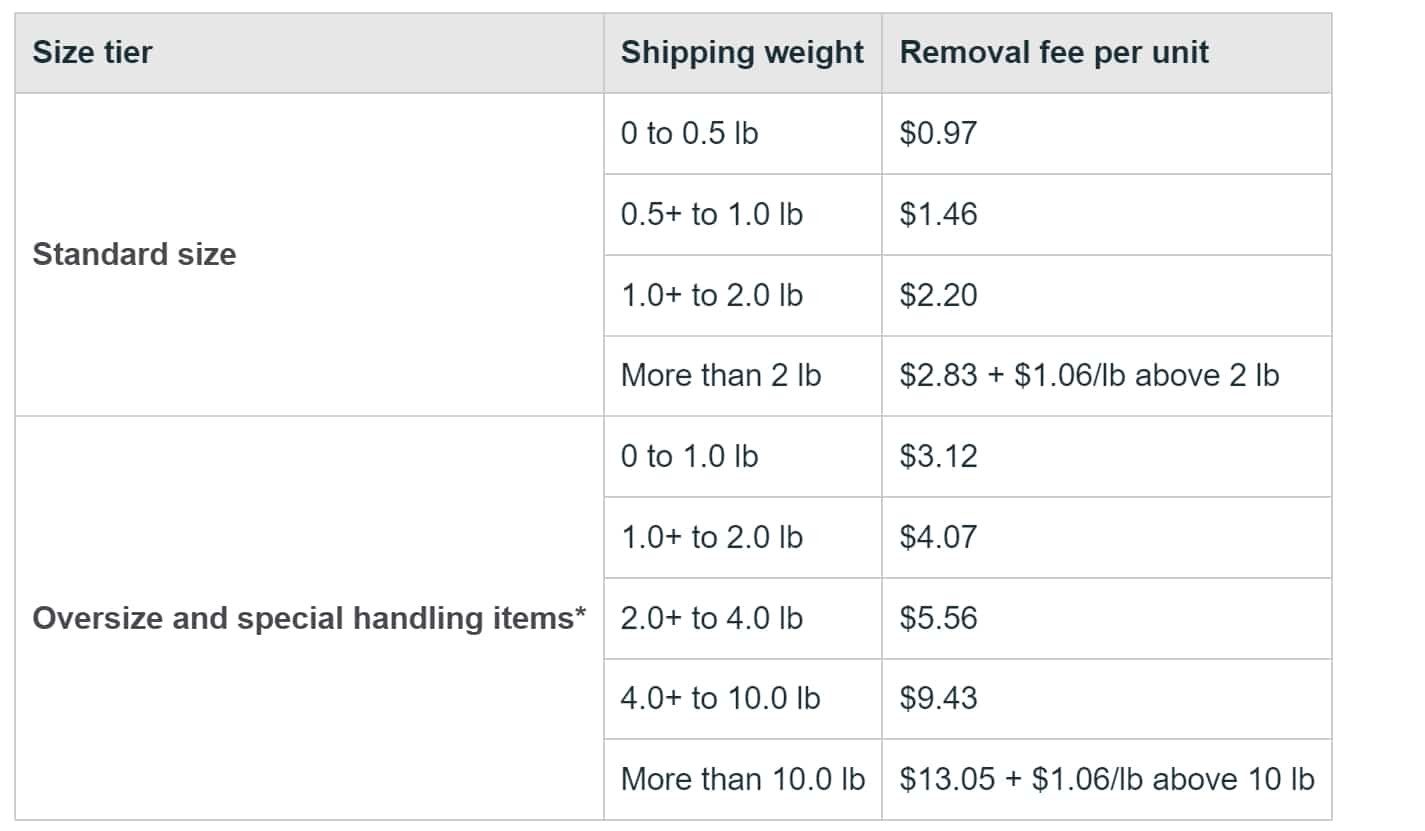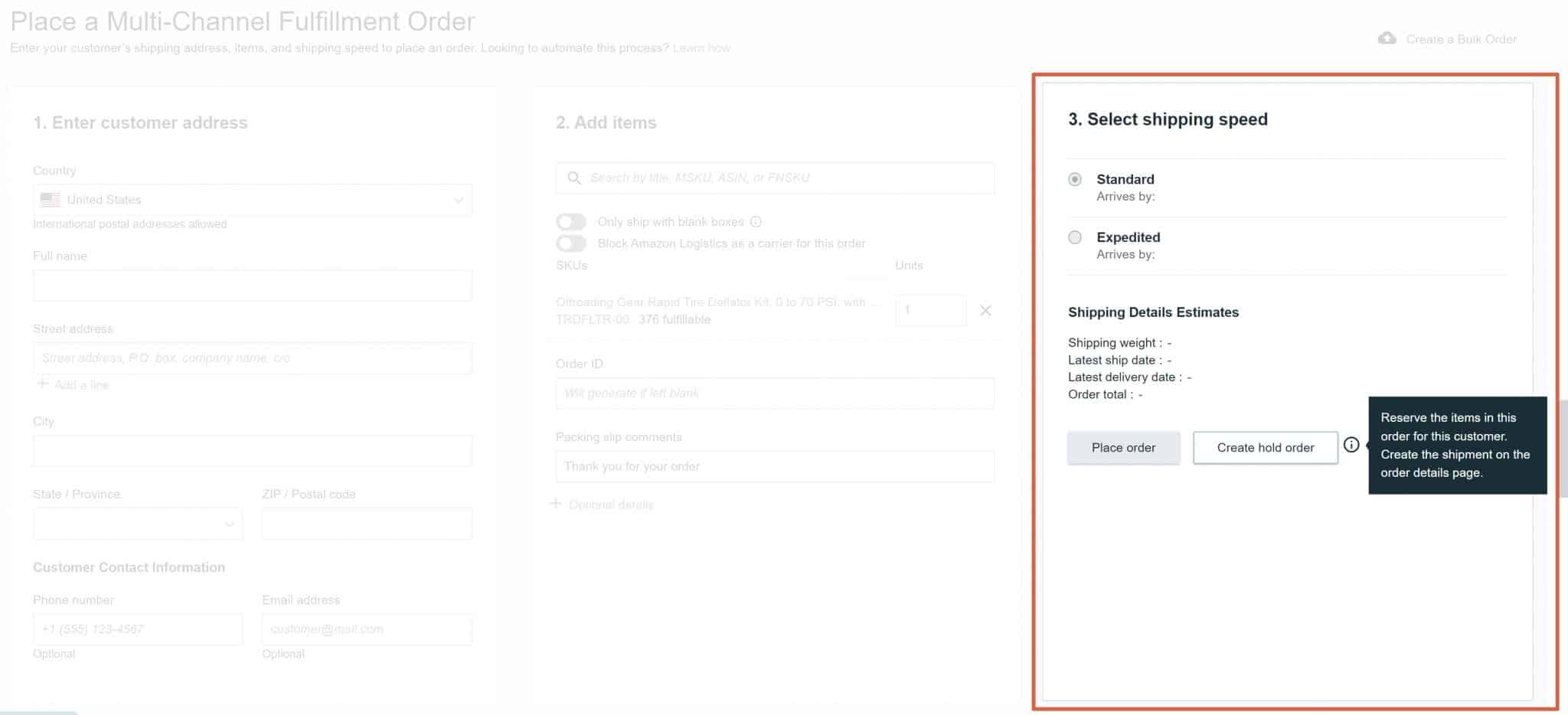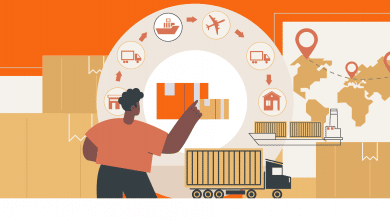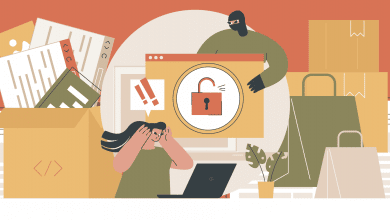Amazon Capacity Manager & How to Avoid Storage Limits [January 2025 Guide]

When Amazon's storage limits were first introduced circa 2019, we thought it was just a temporary measure (in fact, we avoided writing an in-depth topic about this for that very reason). As of this writing though, 2025, they appear here to stay indefinitely.
In this article, we'll break down exactly how Amazon's storage limits work and, most importantly, how to get around them.
2023 Changes to Amazon Storage Limits & Capacity Manager
Amazon's policy towards storage limits has been changing (and fairly dramatically) for the last several years. The latest big change took place in 2023 with the introduction of Capacity Manager. Capacity Manager gives sellers a monthly forecast (three months into the future) of what their storage limits will be, in cubic feet, across all different item size tiers (Standard-size, Oversize, Extra-Large, etc.)
Much to the pleasure of sellers, Amazon also got rid of an ill-thought-out ASIN limit and moved to an overall storage limit (measured in cubic feet). Concurrently, Amazon also gave sellers the ability to bid on more space.
Here's a summary of the changes with Capacity Manager:
- There is no more ASIN limit. It's been replaced by a single storage volume limit.
- Capacity is calculated per month, not per week. The capacity is announced in the third week of the month prior.
- You can bid on more capacity for any individual month up to three months in advance.

The ability to bid on more capacity is the biggest change to all of this. But is this a money grab or just a deterrent for people to manage their inventory better? Let's take a look.
What About My IPI Score? Is It Still Relevant?
If you've been a seller for some time, you know circa-2020 Amazon rolled out the IPI score which is a rating Amazon gives you between 0 and 1000 for how well you manage your inventory. Each quarter you had to meet a certain threshold (either 400 or 450) or you'd have your storage limits reduced.
So is IPI still relevant? Amazon says they still use your IPI score when calculating your Capacity Manager storage limits but they're not clear exactly how it's used. For the most part though, IPI scores are just another barometer for how well you're doing but is not nearly as important as it once was.
How to Bid on Higher Amazon Storage Limits
Amazon now allows you to bid on more capacity. But how much should you bid? This will fluctuate, but currently, Amazon is suggesting that the average bid was about $2 per cubic foot (although it has been as high as $5 per cubic foot!). You bid on more storage limit increases via the capacity manager.
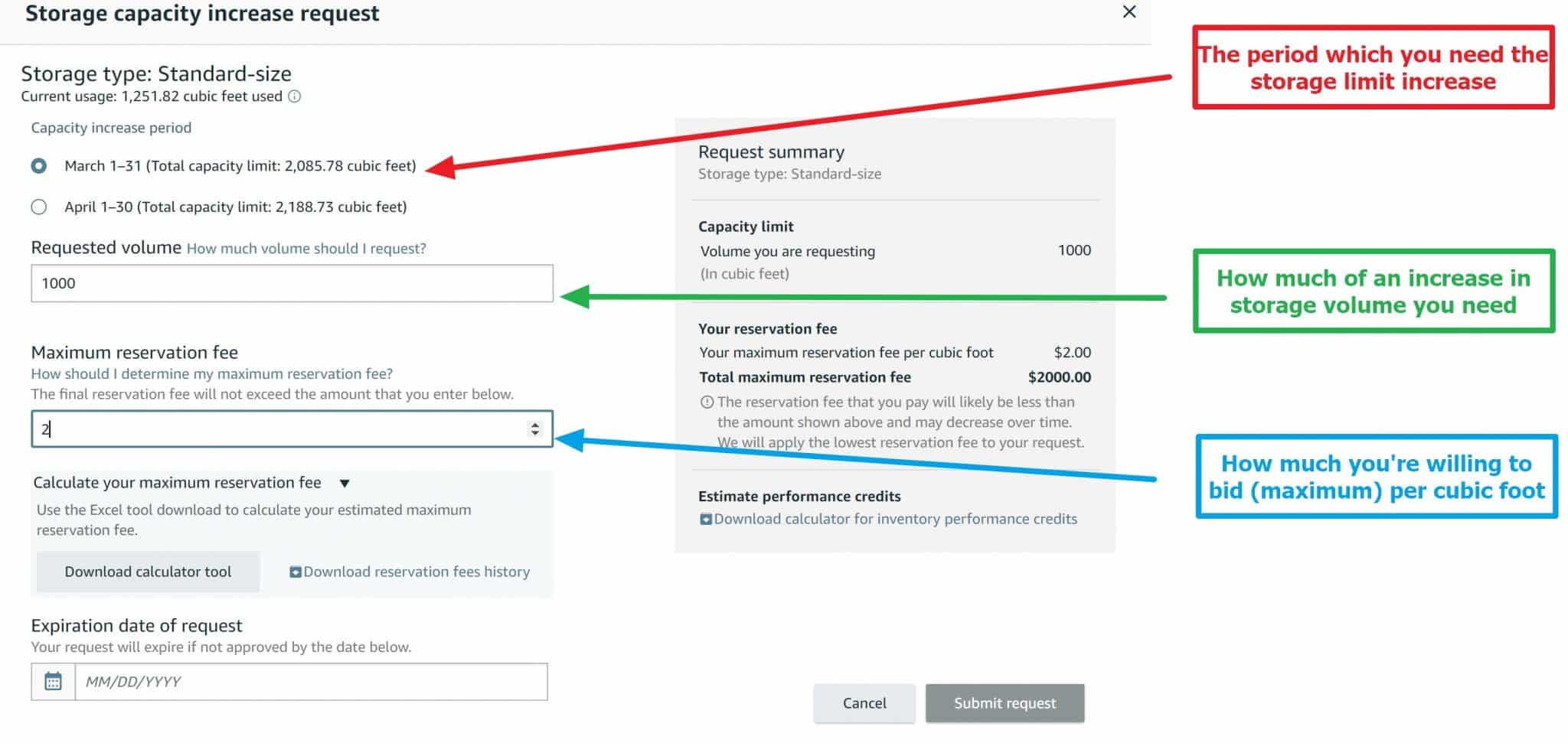
Now here is where things get confusing. Amazon is giving people “performance credits” which reward good behavior, e.g., selling through your inventory in a reasonable amount of time.
For example, let's say that you currently have a capacity limit of 5,000 ft3. You want to increase it by an additional 1250 ft3 (or a 20% increase). Amazon will give you credit for each dollar of sales pro-rated by the percentage increase of storage you requested. So in our case here, Amazon would allow 20% of your sales to get performance credits, and they will give you 15% of those sales as performance credits. Confused? Don't blame me, but allow me to give a few more examples:
- Example 1: You have a 5,000 ft3 capacity. You request a 20% increase (1250 ft3) in April and bid $2/ft3 or $2,500.
You sell $100,000 in April. You receive $100,000 x 20% x 15% in performance credits ($3,000) to offset your bid for more capacity.
In this case, you will pay $0 for the additional storage space. - Example 2: You have a 5000 ft3capacity. You request a 20% increase (1250 ft3) in April and bid $10/ft3 or $12,500.
You sell $100,000 in April. You receive $100,000 x 20% x 15% in performance credits ($3,000) to offset your bid for more capacity.
In this case, you will pay $9,500 for the additional storage space. - Example 3: You have a 5000 ft3 capacity. You request a 20% increase (1250 ft3) in April and bid $2/ft3 or $2,500.
You sell $10,000 in April. You receive $10,000 x 20% x 15% in performance credits ($300) to offset your bid for more capacity.
In this case, you will pay $2,200 for the additional storage space.
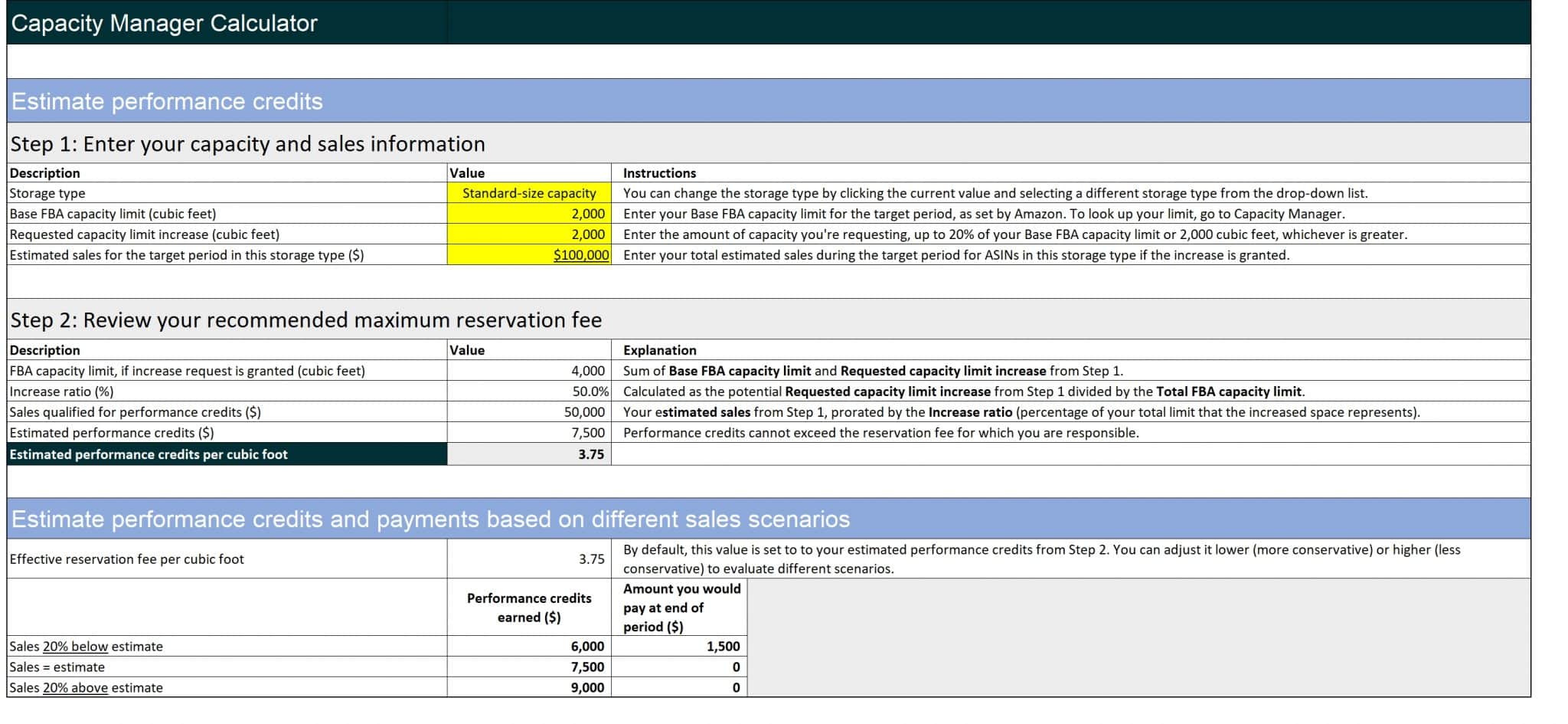
Amazon has an Excel template you can use to estimate your actual costs, but it's equally as confusing. The point is though, hypothetically, if you don't request too much additional space and you sell a lot of stuff, you won't pay anything for your reservation fee.
Options to Get Around Storage Limit Increases
Let's discuss some options you have to get around storage limits:
- Bid on more storage space (see above). This is only good for up to a 20% increase or 2,000 ft3.
- Cancel open shipments you don't plan on using. This is easy, but you probably don't have many.
- Remove excess inventory (you probably don't want to do this though).
- Use Amazon Store & Distribute/Amazon Warehousing and Distribution (AWD).
- Store more stuff at a 3PL and drip inventory in.
- Create multi-channel fulfillment hold orders (clears up space temporarily and a bit of a gray hat strategy).
Let's take a look at a few of these options.
Canceling Open Shipments and Removal Orders
If you have Open Shipments on Amazon that you never plan on shipping in, you should cancel these immediately. This will instantly free up that inventory from being counted against your limit (remember, the second you create an FBA Inbound shipment, the products in that shipment count against your available inventory limit).
The other option is to actually remove inventory (or dispose of it). Removing inventory from Amazon is never an ideal situation because of the high costs associated with it, but it does free up your inventory space immediately.
The issue is that Amazon now imposes quite high removal fees, essentially $1/pound. Also, consider that inbound fees are typically going to cost you somewhere between $0.25 to $0.50 inbound (with all carrier and 3PL fees considered). That's a lot of money you're throwing away to clear up space.
Amazon Warehousing and Distribution (AWD)
Amazon Store and Distribute (formally called Upstream) allows you to ship products into secondary Amazon warehouses. From there, Amazon will send and replenish your inventory as needed. Best of all, you face no inventory storage limits in these secondary warehouses. Sounds good, right? Well, there are a bunch of catches and fees.
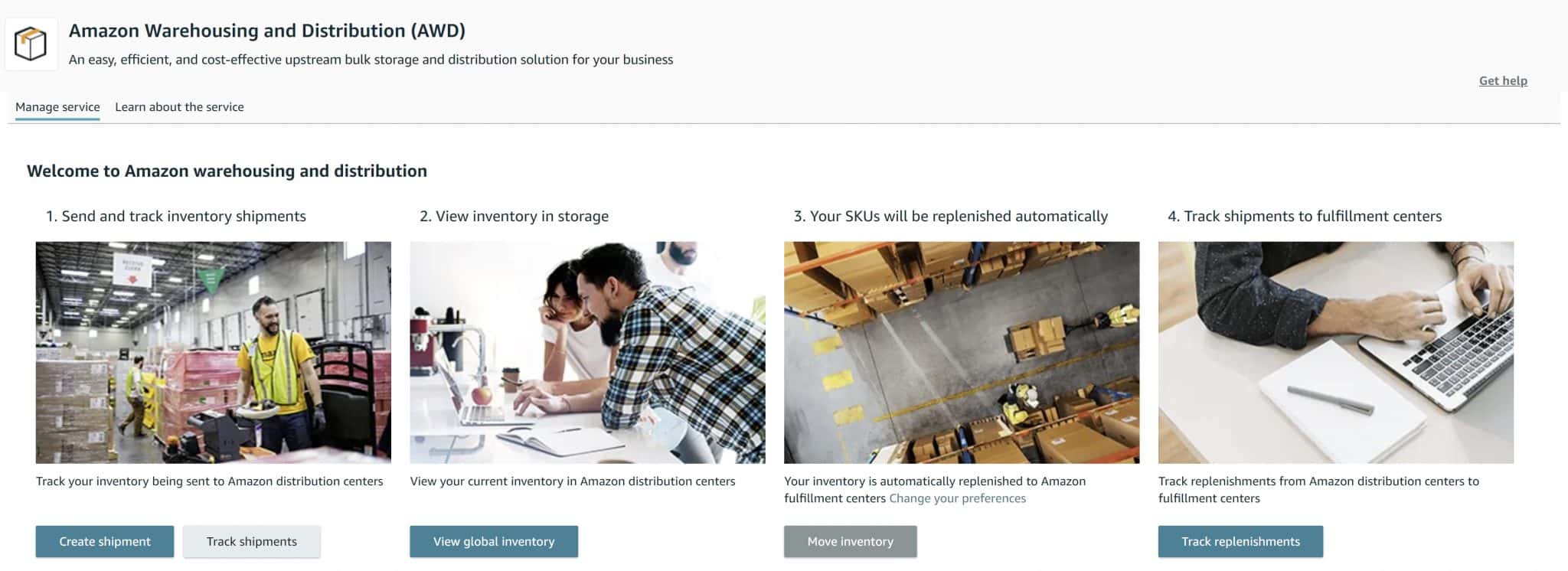
So what are these catches? Here's a summary of them:
Pros & Cons of Amazon Warehousing and Distribution
Pros
- No inventory limits (woohoo)
- Amazon automatically replenishes your inventory in FBA warehouses
- Works with Amazon AGL
- Your items will always have the Buy Box as long as they're either at AWD warehouses or FBA
- Easy to set up
Cons
- Only standard-size items are allowed
- No partnered carrier and you must ship in via LTL
- Has a history of not replenishing inventory in a timely manner to FBA warehouses
- Lots of extra fees, including regular Amazon storage fees + $2 processing fee per box plus transportation fees of $1/ft3
The biggest issue with AWD is that it's only available to standard-size items at this time, there are no partnered carriers available, and you need to ship in via LTL (and non-partnered carrier LTL into Amazon can get very expensive). The extra fees aren't terrible, but they do add up.
Send More Products to a 3PL
Once you hit your inventory limits, you basically have no other option but to store your products outside of Amazon's main warehouses. If Amazon “Store and Distribute” doesn't work for you, that basically leaves using a 3PL (or your warehouse/store facilities if you're so lucky).
3PLs are expensive though (as we all know). Typically, you're going to pay $5+ per carton in receiving and outbound fees once you consider all of the various fees you'll get charged:
- Pick and Pack Fees (outbound)
- Receiving fees/de-stuffing fees
- Per order fees
- Pallet fees
- And so on.
If you're a sub-8-figure seller and think you're paying less, you're probably calculating it wrong. The good news is that with a 3PL, you'll typically pay less in storage fees (especially outside of Peak) than you will with Amazon (most 3PLs charge $15 to $35 per pallet where as Amazon's overall yearly average is well above $60/pallet).
For more information, see our ultimate guide to finding a great 3PL.
Creating Multi-Channel Fulfillment Hold Orders (and Canceling Them Later)
We're tip-toeing into grey hat techniques here.
You can create what is called a multi-channel fulfillment (MCF) hold order. An MCF hold order is going to place an order of products in a hold status and free up that inventory space until those products either ship or get canceled. In this case, you're almost certainly going to cancel them within two weeks (hold orders have a max hold time of 2 weeks). You can also only do a max quantity of 249 items.
This is a loophole right now and not explicitly forbidden by Amazon (especially as they're trying to pump MCF more and more). Chances are that sometime in the near future, this loophole will be closed.
Conclusion
Amazon storage limits are, unfortunately, likely to stay for the considerable future. For many sellers, these storage limits have created massive problems for getting inventory into Amazon. Thankfully, there are some techniques to get around these limits, although most of them are going to add, at a minimum, complexity to your business and, most likely, complexity plus costs.
What strategies have you taken to get around Amazon's storage limits? Let me know in the comments below.
